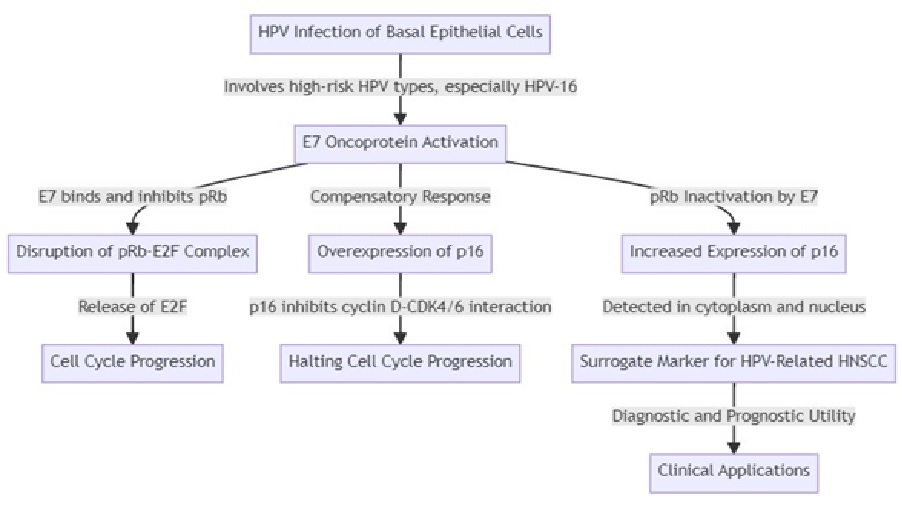Role of Human Papilloma Virus in Carcinogenesis of Head and Neck Squamous Cell
Main Article Content
Abstract
Background: Head and neck squamous cell carcinoma (HNSCC) is a malignancy that occur in head and neck region and originates from squamous epithelial cell in the upper respiratory tract mucosa. This malignancy has a high heteregenicity. Carcinogenesis due to HPV infection has a different moleculer pathway from HNSCC without HPV infection.
Methods: We searched Pubmed collection for open access and English language articles publish access from years 2016-2022 with keyword HPV, HNSCC and carcinogenesis.
Results: We had 16 articles that matched from the keywords. The mechanism of HPV leading carcinogenesis in HNSCC because the HPV has a specific protein that can cause malignant transformation in squamous epithelial cells. The E6 protein inactivates the p53 tumor suppressor gene by activating the ubiquitin ligase E6AP causing degradation of p53. The E7 protein inactivates the pRb (protein retinoblastoma) tumpr suppressor protein by blocking the interaction between pRb and E2F, causing E2F depression.
Conclusion: Carcinogenesis and malignant transformation in HNSCC correlated with HPV infection (high risk type) via the E6 and E7 proteins. This combination can causes abnormal cell cycle and leads cells to escape cell cycle control and get a malignant transformation.
Article Details

This work is licensed under a Creative Commons Attribution 4.0 International License.
How to Cite
References
Gupta N, Gupta R, Acharya AK, Patthi B, Goud V, Reddy S, et al. Changing Trends in oral cancer - a global scenario. Nepal J Epidemiol. 2016;6(4):613–9.
Sung H, Ferlay J, Siegel RL, Laversanne M, Soerjomataram I, Jemal A, et al. Global Cancer Statistics 2020: GLOBOCAN Estimates of Incidence and Mortality Worldwide for 36 Cancers in 185 Countries. CA Cancer J Clin. 2021;71(3):209–49.
Tornesello ML, Perri F, Buonaguro L, Ionna F, Buonaguro FM, Caponigro F. HPV-related oropharyngeal cancers: From pathogenesis to new therapeutic approaches. Cancer Lett. 2014;351(2):198–205.
Marur S, Forastiere AA. Head and Neck Squamous Cell Carcinoma: Update on Epidemiology, Diagnosis, and Treatment. Mayo Clin Proc. 2016;91(3):386–96.
McDermott JD, Bowles DW. Epidemiology of Head and Neck Squamous Cell Carcinomas: Impact on Staging and Prevention Strategies. Curr Treat Options Oncol. 2019;20(5):1–13.
Spence T, Bruce J, Yip KW, Liu FF. HPV associated head and neck cancer. Cancers (Basel). 2016;8(75):1–12.
El-Naggar AK, Chan JKC, Rubin Grandis J, Takata T, Slootweg PJ. WHO classification of head and neck tumours. Lyon: IARC; 2017.
Chung CH, Gillison ML. Human papillomavirus in head and neck cancer: Its role in pathogenesis and clinical implications. Clin Cancer Res. 2009;15(22):6758–62.
Kreimer AR, Clifford GM, Boyle P, Franceschi S. Human Papillomavirus Types in Head and Neck Squamous Cell Carcinomas Worldwide : A Systematic Review Human Papillomavirus Types in Head and Neck Squamous Cell Carcinomas Worldwide : A Systematic Review. Cancer Epidemiol Biomarkers Prev. 2005;14(February):467–75.
Leemans CR, Braakhuis BJM, Brakenhoff RH. The molecular biology of head and neck cancer. Nat Rev Cancer. 2011;11(1):9–22.
Husain N, Neyaz A. Human papillomavirus associated head and neck squamous cell carcinoma : Controversies and new concepts. J Oral Biol Craniofacial Res. 2017;7(3):198–205.
Sritippho T, Chotjumlong P, Iamaroon A. Roles of Human Papillomaviruses and p16 in Oral Cancer. Asian Pacific J Cancer Prev. 2015;16:6193–200.
Stanley MA. Epithelial cell responses to infection with human papillomavirus. Clin Microbiol Rev. 2012;25(2):215–22.
Lechner M, Liu J, Masterson L, Fenton TR. HPV-associated oropharyngeal cancer: epidemiology, molecular biology and clinical management. Nat Rev Clin Oncol. 2022;19(5):306–27.
Sharkey Ochoa I, O’Regan E, Toner M, Kay E, Faul P, O’Keane C, et al. The Role of HPV in Determining Treatment, Survival, and Prognosis of Head and Neck Squamous Cell Carcinoma. Cancers (Basel). 2022;14(17):1–20.
El-naggar AK, Westra WH. P16 Expression as A Surrogate Marker for HPV-Related Oropharingeal Carcinoma : A Guide for Interpretative Relevance and Consistency. Head Neck. 2012;(April):459–61.
